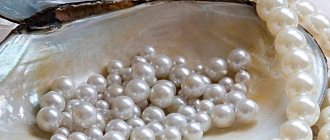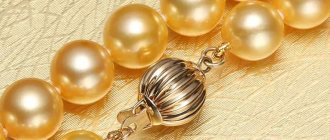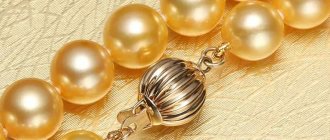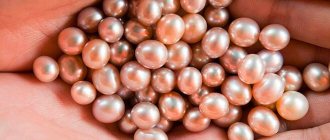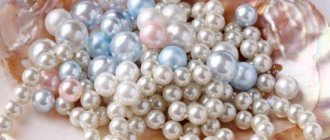In ancient times, it was believed that pearls appear at the moment when oysters rise from the bottom of the sea at dawn and open their shells to collect dew droplets. These drops subsequently turned into pearls. Alas, this is just a legend. We will tell you some interesting facts about pearls that you didn’t even know about.
It is unlikely that anyone will argue with the fact that pearls are in fashion in any weather. Jewelry made from this precious mineral goes with any outfit: wear a necklace with a black sheath dress for a classic look in the style of Audrey Hepburn, add earrings to an elegant blouse and the look of a modern businesswoman is ready. However, this is not all there is to know about pearls.
Fact 1: Pearls were first used in ancient civilizations
Pearl earrings from Ancient Rome.
For the first time, pearls were used as decoration in Chinese, Greek, Roman, and Assyrian civilizations. But the Egyptians bypassed it - they were famous for making necklaces, bracelets, and rings from other precious materials. Now archaeologists are constantly finding new pearl jewelry and after research it turns out that one is older than the other. For example, in Qatar (a state in the Middle East) there are products that are approximately 5,000 years old. And in one of the Japanese museums there is a pearl jewelry that was found 10,000 years ago.
The Persian Gulf is considered the historical birthplace of pearls. However, there are deposits of the mineral in Venezuela. Christopher Columbus first learned about this during his journey. It happened like this: the navigator stopped on one of the coasts of South America, and when he was preparing a dinner consisting of oysters on the fire, he discovered a pearl inside it. After this discovery, pearl production increased several times.
Climate against shellfish
Once upon a time, the freshwater pearl fishery was one of the most prosperous in the North-West; it was supplied to the royal court and exported. In museums you can see kokoshniks richly decorated with pearls and other elements of traditional northern costume. However, by the beginning of the 20th century, the European pearl mussel - a source of valuable commodity - found itself in danger of extinction, and the fishery died for a long time.
Today, pearl mollusks are only studied and protected. But along with the increase in their numbers, questions began to arise about the prospects for the revival of fishing or artificial cultivation of pearls, which is widely practiced in Asian countries.
In the Northwestern Federal District, the European pearl mussel is preserved in the rivers of the Arkhangelsk and Murmansk regions, as well as Karelia.
“The eastern border of its modern range runs along the Solza River near Severodvinsk, and the western border is in Portugal,” notes leading researcher at the Federal Research Center for Integrated Study of the Arctic, Ural Branch of the Russian Academy of Sciences, Candidate of Biological Sciences Ilya Vikhrev. — The range is quite large, but fragmented in places. For example, pearl mussels have practically disappeared in the Novgorod and Leningrad regions, where in the old days the fishery was widely developed. It was first mentioned in sources of the 15th century, but it probably existed before. With the advance of the Novgorodians to the north, pearl mining began in the river basins of Lake Onega, the White Sea and on the Kola Peninsula.
The volumes of production amounted to tons, and shells were opened 500 times more. The fishermen calculated that a pearl could be found in only one out of a hundred shells, and one that was not ashamed to be sent to court - in one out of a thousand.
But it was not just mass fishing that led to the decline in the shellfish population, but a whole complex of reasons, scientists believe. Otherwise, with the cessation of production, the problem would have disappeared, but this did not happen.
The fact is that the pearl mussel is very demanding on environmental conditions, explains Ilya Vikhrev. First of all, she needs cold, clean rivers.
The development of the timber industry has negatively affected the shellfish population
— The population was negatively affected by the development of the timber industry. The rafting of timber along the rivers was greatly influenced by moths. Logs sometimes sank, and bark, branches and other debris fell into the water. In addition, to make rafting easier, engineering work was carried out: the riverbed was straightened and dams were built. All this changed the habitat of pearl mussels. The water was no longer clear, the bottom became muddy. With the development of transport, moth rafting was abandoned, but deforestation continued, which led to soil erosion and also deteriorated the river’s ecosystem. The problem was exacerbated by the construction of roads and bridges. In general, the more the river basin is developed, the worse the pearl mussel feels, the scientist concludes.
The same processes also reduced the number of fish, including salmon. And the larvae of mollusks - glochidia - are attached to the gills of salmon and brown trout during growth. For northern pearl mussels, this period takes up to nine months. Today there are especially many of them in the area of fish breeding factories.
Climate warming has become a new challenge for sensitive mollusks. Arkhangelsk scientists, together with colleagues from other countries, conducted a large-scale study from Spain to the Kola Peninsula. It turned out that the condition of pearl mussels depends on the temperature of the air and water. In the southern regions, the population, as biologists put it, is in a more depressed state. Mollusks grow quickly there, but do not live long; their reproduction does not have time to compensate for the decline. And for the slowly growing northern pearl mussels, two hundred years is the usual life expectancy.
Scientists have calculated: the population of these mollusks in the Arkhangelsk region today is over half a million individuals, in the Murmansk region - more than a million, and in the north of Karelia - more than two million.
“Compared to the countries of Western Europe, our situation with pearl mussels is favorable,” says Ivan Bolotov, director of the FITSKIA Ural Branch of the Russian Academy of Sciences, corresponding member of the Russian Academy of Sciences. — In the Arkhangelsk region, we examined all the rivers where pearl mining had previously taken place. The pearl oyster still lives in each of them today. That is, we have not lost any of the pearl rivers.
All of them are located in a sparsely populated forest area where there are no polluting industries, so the shellfish have been preserved. But still their numbers are much smaller than before. Sources say that in the old days, shells covered the river bottom in several layers.
In the last century, attempts were made to revive the fishery or artificially grow pearls in the North, but this turned out to be unprofitable. Unlike the southern populations, the pearl mussel here takes too long to grow. In addition, the formation of the pearl itself takes ten years. How does this happen? When some irritant - a grain of sand or a pebble - gets into the shell, the mollusk begins to secrete a pearlescent substance that envelops this foreign body. The more layers, the better the quality of the pearl.
— Japan and China have developed an effective method for artificially growing pearls in shells. They contain blanks of different shapes from crushed shells, which are well covered with mother-of-pearl. This is a very profitable business that pays off within 10-15 years. As a rule, jewelry production, a store and a museum are opened on such pearl plantations to attract tourists. But in Asia they use certain types of shellfish that grow quickly, and the climate there is warmer. We calculated that in the North the profitability of such a business would be zero. I would have to wait half a century to get more or less worthwhile pearls, believes Ivan Bolotov.
At the same time, in his opinion, it is still possible to grow artificial pearls on an industrial scale in Russia - in the south of the Far East. Cristaria mollusks live there, which are used on farms in Japan and China.
Meanwhile
Even without fishing, the northern pearl mussel brings enormous benefits as an important part of ecosystems. It is necessary to preserve the poor biodiversity of these territories, emphasizes Ilya Vikhrev. In some areas, bivalves are represented only by pearl mussels. By passing water through itself, it enriches the soil with organic substances, helping other organisms. Not the largest mollusk filters up to 15 liters per day. And these are just some of its functions.
In 2021, scientists will continue researching the European pearl mussel for its genetic diversity in the regions of Russia.
Fact 2: Previously, only virgins could wear pearls
Elizabeth Tudor in a dress embroidered with pearls.
Ancient jewelers considered pearls to be a symbol of purity and innocence, and therefore often associated them with the image of the Virgin Mary. For this reason, most Russian icons depicting the Virgin Mary are decorated with pearls, and this is why brides often wear jewelry made from this mineral to weddings.
The British Queen Elizabeth I wore dresses embroidered with pearls throughout her life. She received this right due to the fact that she was never married.
In ancient times, there was a belief that God sent pearls as a sign. Those people who found it were considered kind, good, honest and worthy.
Fact 3: The fusion of two or more pearls is a very rare phenomenon.
Grand Southern Cross
Until the 19th century, it was believed that in nature there were only single pearls that could not be “united” with each other. However, in 1874 this opinion was refuted. The reason for this was an amazing discovery off the Australian coast - 9 pearls that fused together in the shape of a cross. Subsequently, this miracle of nature was called the “Great Southern Cross”, but disputes regarding its origin have not subsided to this day. Many people think that this grandiose natural phenomenon is actually a pure hoax, since pearls in the shape of a cross were made by man. This hypothesis was not confirmed by facts, thanks to which the “Great Southern Cross” was awarded many medals and awards at famous world exhibitions, and then went to be kept in the Vatican.
How to care for pearls
If you wear pearls with proper care, your jewelry will serve you for a very long time. They can even be passed on by inheritance, although esotericists do not welcome these actions. It is believed that the sea talisman absorbs the owner’s negativity and then passes it on to the next owner.
Care instructions:
- Jewelry should be stored separately from other jewelry. The mineral is very fragile, so try to protect it from falls and impacts with other talismans.
- The stone does not like heat and is afraid of high temperatures. Not only the sun, but also the artificial warm climate recreated indoors. So it’s better not to go to the bathhouse with him.
- By the way, cold and humidity can also harm the amulet. Being in such conditions results in a loss of shine for him.
- This is tricky stuff. It is not only fragile, but also does not like to interact with various substances. Perfume, foundation and hairspray can ruin it. Try to prevent jewelry from coming into contact with cosmetics.
To keep your jewelry beautiful, pearls need to be cleaned. Professionals use a weak solution of acetic acid for this. But if you are afraid to take the wrong proportions, you can replace it with a safer soap solution.
Fact 4: The price of a pearl depends on the owner
Elizabeth Taylor and Coco Chanel
To determine the value of pearls, several factors must be taken into account:
• Firstly, the color - it should be perfectly pure without any inclusions.
• Secondly, shape and symmetry - a perfectly round pearl is considered the rarest, and therefore the most valuable. Also not least is drop-shaped pearls.
• Thirdly, reflectivity – high-quality pearls should reflect light perfectly. As you know, diamonds shine only after they have been cut and polished. But pearls do not require preliminary work.
• Fourthly, belonging to a famous person - Coco Chanel comes to mind first. The fashion designer was contemptuous of jewelry, considering it boring, but she adored pearls and said that he was always right. A string of pearls that belonged to Chanel now costs about 400 thousand dollars. Another famous piece of jewelry belonged to Elizabeth Taylor in the 20th century - the Peregrine Pearl, weighing 56 carats. After the actress's death, the jewelry was bought at auction for $11.8 million.
This is interesting: Pierre Cartier bought a luxurious house on Fifth Avenue for $100 and a string of pearls. At that time, the price of the jewelry was one million dollars (approximately $25,000,000 today).
White color is not a “business card”
White pearls are not the most common, as many may think.
The color range of artificial pearls includes all shades of white and cream (silver-white, cream-gold), as well as peach, deep black, purple, brown, green, and blue. There are more than 30 colors in total!
The main highlight of the color is the smooth tints in the light (“orient” effect).
Pink Conch pearls are considered the rarest. It cannot be cultured because the mollusk dies after opening the shell. The cost of one pearl can reach up to $120,000!
Fact 6: One of the most expensive pearl jewelry cost $7 million
Baroda pearl necklace with diamond clasp from Cartier.
In 2007, a Baroda necklace consisting of several strands and 68 natural pearls, ranging in diameter from 10 to 16 mm, was sold at Christie's for $7 million. They were found in the waters of the Pacific Ocean. The last owner of the Gaekwad pearl is Pratap Singh. According to rumors, his wife found the seven-strand jewelry uncomfortable to wear and remade it into two threads. As for the diamond clasp weighing 8.57 carats, it was created by the French house Cartier. It is noteworthy that the name of the buyer of the necklace is still kept secret.
Fact 7: Pearl tribute was collected in ancient China
Chinese Emperor Yu introduced pearl tribute.
In ancient China, it was believed that pearls fell from heaven (and, apparently, fell directly into the hands of the rulers and their entourage). It was not only a symbol of wisdom, but also one of the most beloved stones of emperors. There is an opinion that the name of the mineral comes from the Chinese “zhen-gzhu”.
In China, pearls have always been an attribute of power and high status. A pearl attached to a headdress symbolized the high position of its owner. And the Chinese Emperor Yu considered the precious material the most valuable offering, which is why he introduced pearl tribute in the state. The mineral even managed to play the role of currency: in Ancient China it was customary to pay for the most expensive and large purchases.
Origin of pearl beads
Pearls are not stones at all, even though they call them that. It owes its appearance to sea and freshwater mollusks, because pearls are formed inside their shells.
The appearance of a pearl is facilitated by the ingress of various debris into the mollusk - from dust particles to microscopic inhabitants of the seabed. The mollusk perceives any foreign body as a potential danger. To avoid possible injury, it begins to secrete a special substance - mother of pearl.
“Perlmutter” is translated from German as “mother of pearls.” By the way, not only the contents of the shell, but also the shell itself can be mother-of-pearl. The inside of the shells of some mollusks is also covered with mother-of-pearl.
It envelops the “alien”, smoothing out all the sharp corners. This is how a pearl is formed. The release of a protective substance does not stop as long as the irritant is in the sink. This usually happens when a shell containing a pearl falls into the hands of a treasure hunter, a professionally trained diver.

